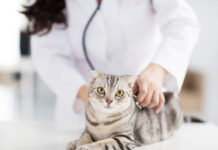Q: Allie, our female Russian Blue mix, is about 7 years old. She’s a strange one, as she must be close to us but won’t be restrained or picked up. We are her second family. Her previous owners surrendered her when the surviving spouse couldn’t keep her.
Allie occasionally will get very antsy, or squirrely, late in the afternoon, with her fur rippling. She’ll suddenly turn and groom as if she had bugs. Then she’ll dash around the room at lightning speed, getting up on the TV console and curling up in a large decorative bowl there.
After a few minutes of this behavior, she returns to her usual placid and self-disciplined self. It’s like “Sundowner’s Syndrome,” only happening in the late afternoon. And this is not a daily occurrence, but random. She is a 100% indoor cat. Could you share your thoughts and advice?
A: Thanks for getting in touch about Allie’s unusual behavior, and while I cannot diagnose her from afar, perhaps a few thoughts about your description of this behavior would be helpful.
The first thing to rule out, of course, is a medical problem that could be causing these issues. As you refer to, making sure that she does not have ectoparasites like fleas, tick, mites, or lice (rare) is important, as is ruling out other skin conditions that can cause itchiness, like ringworm and allergic skin disease. The latter can be due to allergens that are inhaled (like human “hay fever”) or ingested in the food. Food allergies may also cause vomiting and diarrhea.
Once these skin-associated issues are ruled out, it’s important to make sure that she doesn’t have any musculoskeletal problems, such as osteoarthritis, that might be causing her discomfort.
If these medical issues also are ruled out, a good neurologic examination is in order to look for possible central nervous system problems, as the behavior you describe could, in theory, be a form of what is referred to as a petit mal seizure activity (mild seizures), as opposed to the grand mal seizures in which a patient collapses, loses consciousness, and may experience muscle twitching, vocalization, and involuntary urination and defecation.
Once all of these medical conditions have been ruled out, a presumptive diagnosis of a syndrome called feline hyperesthesia syndrome (FHS) is often made. This is a condition whose cause is unknown, and affected cats, demonstrate extreme sensitivity in an area of their skin, often on the back and near the base of the tail.
During episodes, which may be elicited by being touched in these sensitive areas, affected cats may demonstrate skin rippling, dilated pupils, drooling, vocalization, urination, and, in some cases, extreme scratching and self-mutilation (often of the tail). Of course, this can be quite distressing to an affected cat’s owners, as I am sure you can understand.
Some veterinary neurologists feel that this syndrome may be a form of seizure activity. Treatment with gabapentin, an anticonvulsant medication, is recommended. Another important aspect of the management of cats with presumptive FHS is to minimize stress by keeping routines regular and avoiding stressful situations. These circumstances may include introducing new pets/people to the home, having large numbers of guests over, having construction work done in the home, avoiding the frustration of cats seeing other outdoor cats/animals, and moving furniture around.
Thankfully, most cats with FHS can be managed to live happy healthy lives, but it is important that you work with your veterinarian to rule out any medical problems that may be contributing to Allie’s behavior and to devise a management plan that works best.
I hope this is helpful, and please send us an update when you can.ν
Allie’s squirrely afternoon activities have her owners concerned.




